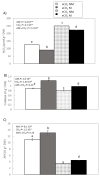Physiological Alteration in Sunflower Plants (Helianthus annuus L.) Exposed to High CO2 and Arbuscular Mycorrhizal Fungi
- PMID: 34066650
- PMCID: PMC8150476
- DOI: 10.3390/plants10050937
Physiological Alteration in Sunflower Plants (Helianthus annuus L.) Exposed to High CO2 and Arbuscular Mycorrhizal Fungi
Abstract
Sunflower plants (Helianthus annuus L.) in a CO2-enriched atmosphere (eCO2) were used herein to examine the developmental and physiological effects of biofertilization with mycorrhizae (Rhizophagus irregularis). The eCO2 environment stimulated colonization using R. irregularis mycorrhizal fungi, as compared to plants grown under ambient CO2 conditions (aCO2). This colonization promotes plant growth due to an increased nutrient content (P, K, Mg, and B), which favors a greater synthesis of photosynthetic pigments. Biofertilized plants (M) under eCO2 conditions have a higher concentration of carbon compounds in their leaves, as compared to non-biofertilized eCO2 plants (NM). The biofertilization (M) of sunflowers with R. irregularis decreased the C/N ratio, as compared to the NM plants, decreasing the hydrogen peroxide content and increasing the antioxidant enzyme activity (catalase and APX). These results suggest that sunflower symbiosis with R. irregularis improves the absorption of N, while also decreasing the plant's oxidative stress. It may be concluded that biofertilization with mycorrhizae (R. irregularis) may potentially replace the chemical fertilization of sunflower plants (H. annuus L.), resulting in more environmentally friendly agricultural practices. This information is essential to our understanding of the mechanisms influencing the C and N dynamic in future climate change scenarios, in which high CO2 levels are expected.
Keywords: C/N ratio; biofertilization; nutrients; oxidative stress; photosynthetic pigments.
Conflict of interest statement
The authors declare no conflict of interest.
Figures

Similar articles
-
Climate Change Impacts on Sunflower (Helianthus annus L.) Plants.Plants (Basel). 2021 Dec 1;10(12):2646. doi: 10.3390/plants10122646. Plants (Basel). 2021. PMID: 34961117 Free PMC article. Review.
-
Responses in Nodulated Bean (Phaseolus vulgaris L.) Plants Grown at Elevated Atmospheric CO2.Plants (Basel). 2023 Apr 29;12(9):1828. doi: 10.3390/plants12091828. Plants (Basel). 2023. PMID: 37176886 Free PMC article.
-
Increasing atmospheric CO2 differentially supports arsenite stress mitigating impact of arbuscular mycorrhizal fungi in wheat and soybean plants.Chemosphere. 2022 Jun;296:134044. doi: 10.1016/j.chemosphere.2022.134044. Epub 2022 Feb 21. Chemosphere. 2022. PMID: 35202662
-
Genetic control of arbuscular mycorrhizal colonization by Rhizophagus intraradices in Helianthus annuus (L.).Mycorrhiza. 2021 Nov;31(6):723-734. doi: 10.1007/s00572-021-01050-5. Epub 2021 Sep 3. Mycorrhiza. 2021. PMID: 34480215
-
[Advances in mechanisms of nutrient exchange between mycorrhizal fungi and host plants].Ying Yong Sheng Tai Xue Bao. 2019 Oct;30(10):3596-3604. doi: 10.13287/j.1001-9332.201910.034. Ying Yong Sheng Tai Xue Bao. 2019. PMID: 31621248 Review. Chinese.
Cited by
-
Response of physiological characteristics of ecological restoration plants to substrate cement content under exogenous arbuscular mycorrhizal fungal inoculation.Front Plant Sci. 2022 Nov 23;13:1028553. doi: 10.3389/fpls.2022.1028553. eCollection 2022. Front Plant Sci. 2022. PMID: 36507450 Free PMC article.
-
Molecular and Systems Biology Approaches for Harnessing the Symbiotic Interaction in Mycorrhizal Symbiosis for Grain and Oil Crop Cultivation.Int J Mol Sci. 2024 Jan 11;25(2):912. doi: 10.3390/ijms25020912. Int J Mol Sci. 2024. PMID: 38255984 Free PMC article. Review.
-
Climate Change Impacts on Sunflower (Helianthus annus L.) Plants.Plants (Basel). 2021 Dec 1;10(12):2646. doi: 10.3390/plants10122646. Plants (Basel). 2021. PMID: 34961117 Free PMC article. Review.
-
Responses in Nodulated Bean (Phaseolus vulgaris L.) Plants Grown at Elevated Atmospheric CO2.Plants (Basel). 2023 Apr 29;12(9):1828. doi: 10.3390/plants12091828. Plants (Basel). 2023. PMID: 37176886 Free PMC article.
References
-
- Vilverta E., Lanaa M., Zandera P., Siebera S. Multi-model approach for assessing the sunflower food value chain in Tanzania. Agric. Syst. 2018;159:103–110. doi: 10.1016/j.agsy.2017.10.014. - DOI
-
- Field C.B., Barros V.R., Dokken D.J., Mach K.J., Mastrandrea M.D., Bilir T.E., Chatterjee M., Ebi K.L., Estrada Y.O., Genova R.C., et al., editors. Contribution of Working Group II to the Fifth Assessment Report of the Intergovernmental Panel on Climate Change. Cambridge University Press; London, UK: 2014. Intergovernmental Panel on Climate Change Climate change 2014: Impacts, adaptations and vulnerability.
-
- Wahid A., Gelani S., Ashraf M., Foolad M.R. Heat tolerance in plants: An overview. Environ. Exp. Bot. 2007;61:199–223. doi: 10.1016/j.envexpbot.2007.05.011. - DOI
-
- Gruissem W., Lee C.-H., Oliver M., Pogson B. The global plant council: Increasing the impact of plant research to meet global challenges. J. Plant Biol. 2012;55:343–348. doi: 10.1007/s12374-012-0901-5. - DOI
Grants and funding
LinkOut - more resources
Full Text Sources
Miscellaneous

